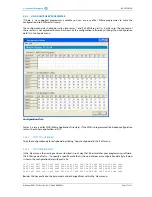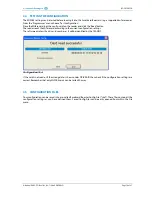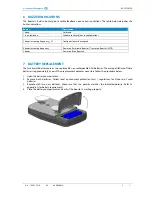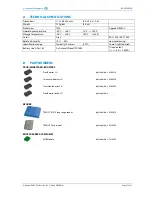
BOOSTERS 2G
© Nedap IDEAS, P.O. Box 103, NL-7140 AC GROENLO
Page 9 of 21
4.2.1
19B
TARGET DEVICE
The Booster Configuration software can be used to configure a number of different devices. The user-interface is
adapted to the selected target device. Select in the ‘Target’ menu which device you are about to configure.
Smartcard-Booster
Transition Booster
Prox Booster EM4x50
not covered in this manual
MTR Module
see chapter 5
4.2.2
20B
CREATION PROCEDURE
Follow the procedure below to create a configuration card with application specific settings.
1.
Specify OPERATING MODE
(see chapter 4.2.2.1)
2.
Specify FRAME LENGTH
(see chapter 4.2.2.2)
3.
Specify ACTIVE_MODE
(see chapter 4.2.2.3)
4.
Specify RFID CONFIGURATION settings
(see chapter 4.2.2.4)
5.
Save the configuration settings into a file.
6.
Write the configuration into a blank Mifare Classic 1K or 4K card.
4.2.2.1
24B
OPERATING MODE
Booster (only Driver-ID)
Up to 16 bytes of data from the personal identification card is read. The Vehicle-ID is omitted.
Combi-Booster (Vehicle-ID + Driver-ID)
Vehicle-ID combined with up to 11 bytes from the personal identification card is read.
Tacho-Booster (Vehicle-ID + Driver-ID + Tacho-Counter)
Vehicle-ID and Driver-ID combined with Tacho-Counter value. If this option is selected than automatically
extended-length is selected.
4.2.2.2
25B
FRAME LENGTH
This affects the length of the message sent to TRANSIT reader.
Extended length (longer Driver-ID)
Select extended-length in order to support all transponder types and maximum amount of data. The
extended-length may be not compatible with older firmware versions in the TRANSIT reader. You might
need to upload new firmware into the reader.
The identification speed is a bit slower compared to applying standard-length.
Standard length (backwards compatible, faster identification)
Select standard-length in applications where compatibility with older types of transponders or where fast
identification is important.
Please note that when reading low-frequency cards with a Transition-Booster this setting is not used.
For NEDAP and EM cards the extended-length is not required and therefore the Booster will automatically use
standard-length (even if extended-length is selected in the configuration).
For HID PROX the extended-length is required so extended-length is used automatically if such a card is
identified (even if standard-length is selected in the configuration).





















